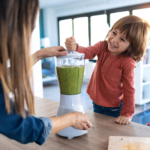Blenders are a kitchen staple, essential for whipping up smoothies, soups, and more. But with so many types on the market, how do you choose the right one? From immersion blenders to powerful countertop models, the options can be overwhelming. In this blog, we’ll break down the different blender types to help you find the perfect fit for your needs.
Types of Blenders
Below, we will break down the most common types of kitchen blenders to help you decide which one is best for you:
1) Countertop Blenders
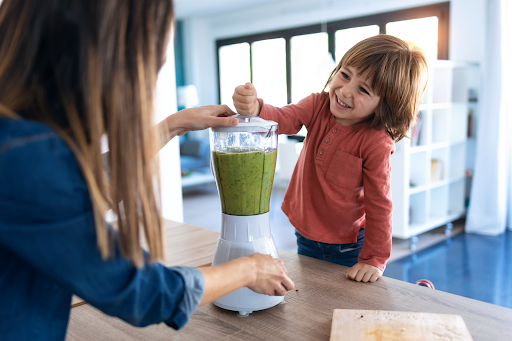
Countertop blenders are the most common types of blenders available in most households. They come with a sturdy base that houses a powerful motor, and a blending jar made of glass, plastic, or stainless steel. The jars are generously sized, usually ranging from 5 to 8 cups, making them suitable for families or meal prepping. They also come with a tight-fitting lid, often with a removable centerpiece that allows you to add ingredients while blending, and multiple blades designed to handle various blending tasks.
Below are the pros and cons of using a countertop blender:
Pros:
- Multitasking Ability: With their powerful motors and versatile blade designs, countertop blenders excel at handling a multitude of tasks. Whether you’re crushing ice for frozen drinks, blending smoothies, or processing ingredients for baking, they can handle it all.
- Increased Control: Most countertop blenders come equipped with multiple speed settings and pre-programmed options. This gives you precise control, ensuring your recipes turn out just the way you want them in terms of consistency and texture.
- Large Capacity: Countertop blenders typically feature generous jar sizes, making them the perfect choice for those who frequently cook in larger quantities.
Cons:
- Space Consumption: Due to their larger size and the design of the base and jar, countertop blenders can take up considerable counter and storage space in the kitchen.
- Noise Concerns: These blenders tend to operate at a higher noise level due to their powerful motors. This can be somewhat disruptive, especially when used for prolonged periods or in quieter settings.
- High Maintenance: While they are generally easy to clean, the various parts, settings, and sometimes even the additional attachments, can make maintenance and cleaning a bit more labor-intensive compared to simpler, less multifunctional blenders.
2) Hand or Immersion Blenders
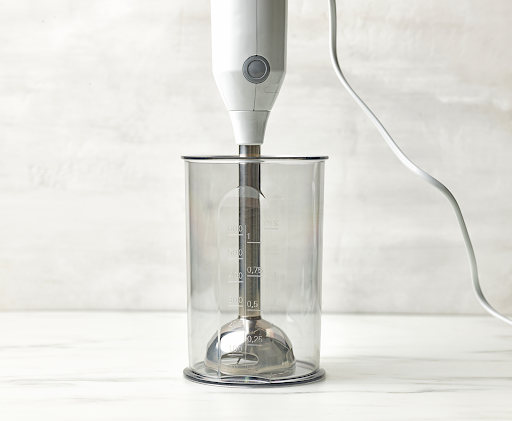
Hand blenders, also popularly known as immersion or stick blenders, are the compact alternatives to their larger countertop counterparts. These blenders are designed for direct immersion into pots, bowls, or cups, allowing for easy, instant blending. They have a stick-like structure with blades and a protective guard. The operation is button-based, situated on the handle, allowing users to blend with a single hand.
Below are the pros and cons of using an immersion blender:
Pros:
- Ease of Use: Hand blenders are incredibly user-friendly, allowing you to blend directly in cooking pots or serving dishes. This feature not only simplifies the blending process but also minimizes the need for extra cleanup.
- Space-Efficient: With their slender and compact design, they are a perfect fit for smaller kitchens. They take up minimal space and are easy to store.
- Increased Control: Hand blenders offer superior control and precision during blending. Their handheld design allows for a hands-on experience, making it easier to make adjustments.
Cons:
- Power Limitation: They typically have less power compared to countertop models, which might make handling tougher ingredients or achieving super-smooth textures challenging.
- Limited Capacity: Given their design, hand blenders are more suitable for smaller quantities, and extended use may lead to overheating.
- Durability Issues: While they are handy, they might not be as durable or long-lasting as some of the more robust countertop models, especially when used frequently or for tougher blending tasks.
3) Single Serve or Personal Blenders
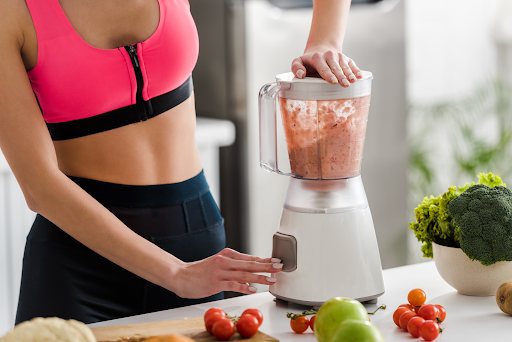
Personal or single-serve blenders are compact kitchen blenders designed for blending small portions of ingredients, typically for one person. They consist of three main parts: a motor base, a blade assembly at the bottom, and a blender jar that you can also use as a drinking cup. They are designed for fitness enthusiasts and those who are on the move since they allow you to quickly whip up your favorite smoothies or shakes before heading out the door.
Below are the pros and cons of using a personal blender:
Pros:
- Increased Efficiency: Personal blenders are designed for quick and hassle-free blending, making them ideal for busy mornings or whenever you need a quick refreshment.
- Ease of Cleanup: With the option to blend directly in the serving cup, there are fewer parts to clean, simplifying the cleanup process and saving you time.
- Space-Saving: Their compact design takes up minimal counter and storage space, making them a great choice for smaller kitchens or areas with limited space.
Cons:
- Limited Capacity: These blenders are primarily designed for single servings, so they may not be suitable for preparing larger quantities or full meals.
- Reduced Versatility: Their design and power are usually suited for simple blending tasks like smoothies or shakes. They might struggle with more complex blending needs.
- Questionable Durability: Due to their portable design and lightweight construction, they might not be as durable or long-lasting compared to more robust countertop models.
4) Commercial Blenders
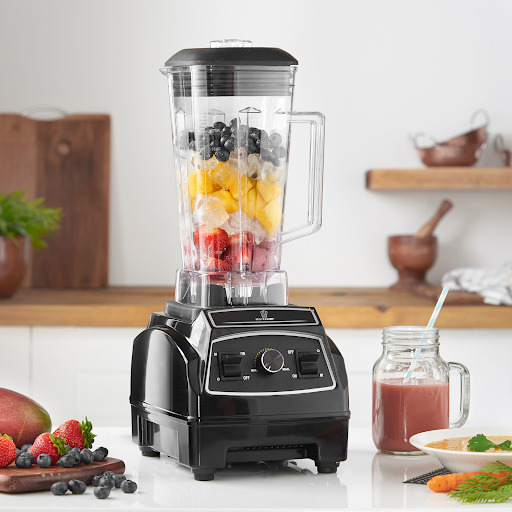
Commercial blenders like the Misterchef Professional Blender are the go-to choice for professional kitchens. These machines can handle it all, from blending frozen fruit to crushing ice and processing hard ingredients like nuts and seeds. With strong motors, multiple speed options, and high-quality blades, they operate at impressive speeds to create smooth blends and perfectly pureed recipes.
Here are the pros and cons of using a commercial blender:
Pros:
- Increased Power and Performance: Equipped with strong motors, these blenders excel in handling a diverse range of ingredients and tasks, ensuring smooth and refined results.
- Enhanced Versatility: They can effortlessly transition between different functions, from blending and chopping to grinding, making them exceptionally versatile kitchen tools.
- Improved Durability: Built with high-quality materials and advanced technology, commercial blenders tend to have a longer lifespan and superior durability.
Cons:
- Higher Price: Commercial blenders often come with a higher price tag compared to other blender types.
- Larger Size and Weight: Their robust construction and powerful motors make them bulkier and heavier than average, requiring more storage and counter space.
- Noise Issues: Due to their powerful motors, commercial blenders may operate at higher noise levels.
Factors to Consider When Choosing a Kitchen Blender
Selecting the right kitchen blender from the array of options available can feel overwhelming. To simplify this task and help you make a well-informed decision tailored to your needs, here are some essential factors to consider:
1) Power and Performance
The blender’s wattage or motor power is a crucial factor in determining its effectiveness. Higher wattage often means smoother and faster blending, especially when dealing with challenging tasks like crushing ice or grinding nuts. So, if you’re into power-packed performance, keep an eye on the wattage.
2) Capacity and Size
Think about the volume of ingredients you typically blend. If you’re preparing drinks or meals for a family, a larger capacity might be ideal. However, for single servings or small kitchens, a compact design might be more suitable.
3) Blade Quality
Look for blenders with strong, durable blades. Stainless steel is often a good choice, as it’s resilient and maintains its sharpness well. Also, pay attention to blade design; it should be able to create a consistent blend, reaching every nook and cranny of the jar or cup.
4) Extra Attachments and Accessories
Some blenders come with bonus features such as a food processor, ultra-sharp blades for ice and smoothie ingredients, heating elements for making soups, or extra blender jars. Assess whether these additional features align with your cooking needs and preferences.
Which One Should You Choose?
The choice of blender ultimately depends on your personal needs, lifestyle, and the types of tasks you plan to undertake. Here’s a guideline to help you make a decision:
- For the Health Enthusiast: If you’re primarily into making smoothies, protein shakes, or other health drinks, a single-serve or personal blender might be the best choice due to its convenience and portability.
- For the Culinary Adventurer: If you love experimenting with a variety of recipes, from soups to doughs, and need something versatile and powerful, consider investing in a commercial blender like the one from Misterchef.
- For the Everyday Cook: For everyday kitchen tasks like making sauces, soups, or occasional smoothies, a countertop blender would be a solid and versatile choice.
- For Precision and Control: If you often find yourself needing to blend hot ingredients directly in the pot, or you value precise control over the blending process, an immersion or hand blender could be your ideal tool.
- For Limited Space: For those with smaller kitchens or limited storage, a compact, single-serve blender or a hand stick blender might be more suitable due to their space-saving design.
Summary
Choosing the perfect blender doesn’t have to be complicated. All you need to do is evaluate the features, consider the pros and cons, and make a choice that suits your kitchen and your cooking style. With the right blender, your kitchen will be ready for any blending challenge that comes its way!
Are you tired of struggling with subpar blenders in the kitchen? With Misterchef, you’ll never have to compromise on blending power again. Whether it’s smoothies, soups, or sauces, Misterchef is up for the task. Shop with us today.






